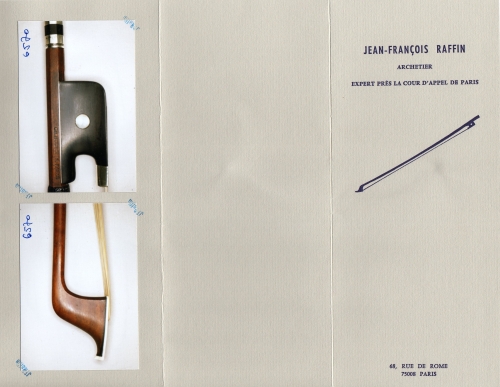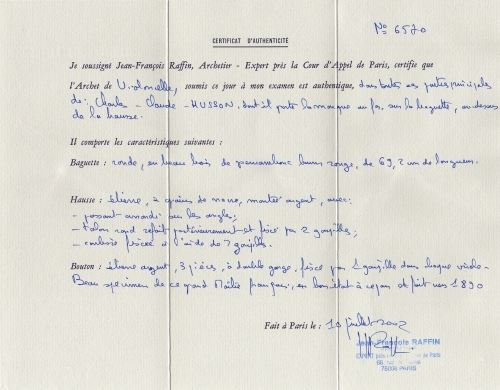THE CERTIFICATES OF AUTHENTICITY
The choice to use an ancient bow instead of a modern one, is obviously related to the way of playing, the feeling and the idea of sound that a single musician owns. In case you choose to play with an ancient bow, it is necessary to be aware of particular details so to avoid bad and "expensive surprises".

Violin bow in turtle and gold – D. Peccatte
Personally, I would spend whole days just watching and studying the bows of the great past maestros, in particular some French ones such as: Tourte, Peccatte or Sartory. Some of them are so nice that give birth to an absurd wish of possessing them. Therefore I understand perfectly the musician’s passion for these little works of art.
After some years spent in this study and even if my knowledge of French, German, English and Italian bowmaking school is rather good, I never even thought about issuing a certificate of authenticity but not only because I do not consider me able to express a sure judgement but because it would not be legal. The problem related to certificates of both instruments and bows is not to ascertain its author but who signs the certificate.
As an example: some months ago a friend of mine brought me a French bow wishing to sell it. The bow was in a perfect condition, both from the aesthetic and mechanic point of view, but being a bow from a French maker he had the problem to be without certificate. The bowmaker that often supplies my customer, gave the bow a name and an evaluation ; I will not reveal – for privacy reasons – the author’s name, just the esteemed value: 18.000 Euro.
If the bow had been an authentic one, the esteem would be the right one but things did not go in the proper way. M° Navea Vera and I examined the bow and were almost convinced that it was a fake, nice and well done indeed but a fake. To get rid of any doubt I suggested my friend to submit this bow to some experts who could give him a final reply: M° B. Millant and M° J.F. Raffin, the two founders of French bowmaking, the only ones whose certificates are considered and accepted as valid worldwide.
Unfortunately M° Raffin’s reply was : “It is surely a nice bow to play with but it is not a French one, its value is 4000 Euro” You can imagine my friend’s reaction, loosing 14.000 Euro in less than 30 seconds.

Certificate of authenticity for a cello bow "C. Husson" issued by M° J.F. Raffin

As you can understand, I told you this story because, if a bow is a very nice one and plays well, that doesn’t mean that it is authentic as well. The market value will be sharply decreased and you can have in your hand a bow that you can sell only by loosing money.
Do not trust dealers that offer bows without any certificate or with an irregular and non-recognized certificate, the sum involved in these purchases are really very high and I can guaranty that there is a lot of fake bows on the market.
I state the experts names that are fully authorized to issue certificates, the school to which they belong and the reference text. Just to make things even clearer I underscore that these are theonly one that are universally recognized.
FRENCH SCHOOL
M° B. Millant: certificate of authenticity and value declaration .
M° J.F. Raffin: certificate of authenticity and value declaration
Reference text:
"L'ARCHET - Les Archetiers Francais 1750 - 1950"- B. Millant, J.F. Raffin, L. Le Canu.
GERMAN SCHOOL
M° Gruenke: certificate of authenticity and value declaration
Reference text :
"DEUTSCHE BOGENMACHER 1783 - 2000" - K. Gruenke, C.H.K. Schmidt, W. Zunterer
ENGLISH SCHOOL
M° C. Beare: certificate of authenticity and value declaration
Workshop Hill: .certificate of authenticity and value declaration
So long
Paolo.
|